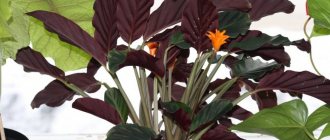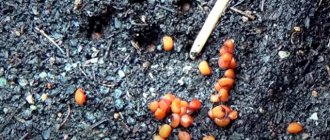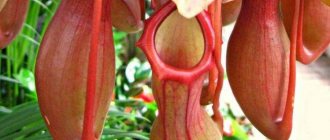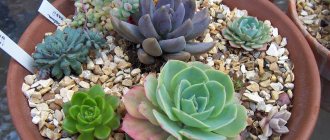Primrose (Primula) is a herbaceous plant from the Primrose family, which unites about 500 species of annuals and perennials. In nature, primrose can grow anywhere where the climate is temperate with sufficient soil moisture. The culture prefers the banks of rivers, mountain streams of North America, Europe, and Asia.
Primrose can be grown in the garden, as well as indoors. For growing in pots, gardeners prefer to choose perennial species that can delight with their flowering throughout the year. But most varieties of primrose bloom in winter and in the first half of spring.
Types and varieties of primrose for growing at home
Garden species adapted to growing outside are more resistant to cold. There are varieties that do well both indoors and outdoors. The types of primroses described below are mainly grown in pots.
Stemless or common (vulgaris)
A hybrid that can be grown both in the garden and indoors. This is a perennial up to 20 cm high, which is found in Asia, Europe, and Africa. The leaves are elongated, elliptical, bright green. The flowers are solitary, placed on thin peduncles. The color of the flowers may vary depending on the variety.
Popular varieties of common primrose:
- Sphinx Aprico,
- Sphinx F1 neon Rose,
- Eclipse Violet with Rim,
- Pioneer F1.
Chinese (chinensis)
Perennial, about 0.3 m high. The leaf blades are petiolate, rounded-heart-shaped, with denticles along the edges, collected in a rosette. Flowers up to 4 cm in diameter are collected in umbellate inflorescences. Depending on the variety, Chinese primrose flowers can be simple or double and vary in shape and shade.
Kewskaya (kewensis)
A rare species that is intended specifically for growing in a pot. The leaves are green, with a whitish coating and jagged edges up to 20 cm long. The inflorescences are umbellate, collected on a long peduncle. The flowers are small, yellow in color.
Soft or soft-leaved (malacoides)
A herbaceous plant native to China, up to 0.5 m high. The leaves are rosette, with serrated edges, heart-shaped or oval. The peduncles are tall, leafless, there can be up to 8 of them on one bush. Each one contains up to 10-20 flowers. They can be red, pink or white, with a yellow spot in the middle. Blooms in late winter - early spring.
Popular varieties:
- Mars,
- White pearls,
- The Snow Queen,
- Juliet.
Obconical
One of the most popular species comes from China, no more than 20 cm high. Perennial with oblong heart-shaped leaves, serrated along the edges. The plant blooms in early winter and spring. But with good care it can bloom almost all year round. Flowers are located on short peduncles. Species obconica contains substances on its leaves that can cause allergies.
New varieties and hybrids have been developed that are safe for allergy sufferers:
- Touch me
- Grace F1,
- Libre F1.
Characteristics of the flower
Primrose, or primrose, has a branched rosette of leaves, in the center of which are flowers of red, pink, burgundy, blue and purple. The leaves are heart-shaped with pointed edges and covered with small hairs. Flowers are collected in inflorescences.
There are a large number of varieties of decorative flowering plants. Among the main ones:
- Malvopodobna (leaves are petiolate, elongated, located next to one another, the rosette is dense, elastic);
- Chinese (flowers are lush and large, exceed the size of the leaves, collected in umbrella inflorescences; exude aroma);
- Kyusskaya (leaves covered with a whitish coating, flowers yellow, fragrant);
- stemless primrose (another name is common. Under natural conditions can be found in the Caucasus and Crimea. Flowers are yellow, white, red, white, purple. Leaves are oval, wrinkled);
- obkonika (leaves with a rough surface covered with small hairs. They are heart-shaped, the inflorescences are umbrellas, located on high stalks, the color is purple, white, yellow);
- Primula Danova (grows up to 14 cm in height. Peduncles are solitary, low, rising low above the rosette of leaves).
Primula obconica is dangerous to health. It can provoke the appearance or exacerbation of allergies. This is due to the presence of an alkaloid in plant cells (leaf hairs) of the flower.
Home care
Primrose is considered a non-capricious plant. Therefore, even an inexperienced gardener can grow it at home. But in order to make the plant bloom long and profusely, you need to create suitable conditions for it.
Location and lighting
The flower loves good lighting. Therefore, it is recommended to place the pot in a bright room, but without direct sun. Windows in an eastern or western location are suitable for primrose. Northern window sills are also allowed if there is enough light on them. The main thing is to avoid drafts. In winter, when primrose blooms, it is necessary to provide it with additional lighting.
Choosing a flowerpot
Small but wide pots are more suitable for primroses. For each subsequent transplant, take a container several centimeters wider than the previous one. You should not take a pot that is too deep to avoid acidification of the soil and rotting of the roots.
Soil and drainage
When choosing soil for primrose, you can choose ready-made mixtures that are designed specifically for Primroses. A substrate for geraniums is also suitable.
You can prepare the substrate yourself:
- leaf soil (1);
- peat (1);
- sand (1);
- turf (1).
Be sure to lay a layer of drainage at the bottom of the pot. This could be gravel, expanded clay, broken shards.
Planting and transplanting
Perennial species and varieties require regular replanting. It is recommended to replant young plants no more than once a year. This can only be done after flowering. During this period, the primrose still has the strength to lay new buds, it quickly adapts to new conditions.
Transplant procedure:
- Place a 2 cm thick layer of drainage in the pot. Sprinkle a little soil on top.
- Remove the primrose from the old pot without damaging the roots.
- Carefully transfer it into a new container. Fill the free space with soil, lightly press it down and water it.
Step-by-step video - instructions for transplanting Primrose after purchase:
Air temperature and humidity
Primrose prefers cool conditions. During flowering, the temperature should be at +12..15°C. For reverse conical primrose – +16..20°С. It is difficult to achieve such a temperature at home. Therefore, from the beginning of spring, you can take the flowerpot out to a cool balcony or veranda. After flowering, you can even plant the plant in the garden under the diffused light of tree crowns. In winter, the flower pot should be placed away from radiators, closer to a cool window.
The crop has no special requirements for air humidity.
But she doesn’t like it if the room is very dry. As a result, the tips of the leaves of the plant begin to dry out. On a note! To increase humidity, you can spray primrose leaves with warm, soft water. It is important to ensure that it does not get on the flowers. Nearby you can place a container of water or a tray with wet expanded clay.
Feeding and fertilizers
You can apply fertilizer after the buds begin to form. It is recommended to use complex fertilizers for flowering plants 2 times a week. But the dosage of the drug should be 2 times weaker than indicated in the instructions. Primrose does not tolerate excess salts. Therefore, it is important not to oversaturate the soil with fertilizers. Fertilize until the end of flowering.
Watering
It depends on the health and flowering of primrose. Watering should be regular but moderate. The soil should always be slightly damp during flowering. To maintain its moisture, you can place the pot on a tray with damp sphagnum moss and periodically add water to it.
When the crop has faded, the soil is moistened only after drying by 2-3 cm. During rest, the plant should be watered less frequently, avoiding stagnation of water and acidification of the soil.
Flowering period
Unlike most other indoor plants, which go into a dormant period in the fall, for primroses this is the period when they prepare to bloom. Primrose requires regular watering, spraying, and good lighting. It can bloom in different shades, depending on the species. To prolong flowering, it is necessary to trim off faded flowers in time.
First steps after purchase
Once purchased, it is not recommended to touch the flowering bush. At the end of flowering, it should be transferred to a new container. The pot should be low but wide. A large pot volume leads to intensive growth of the root mass and slows down the flowering process.
A soil mixture for flowering plants is suitable as soil. A new container needs to be filled with substrate and a small depression made in the center. The plant should be transferred into it by transshipment along with a lump of earth. At the end, near the main stem, the soil should be lightly compacted and watered.
Reproduction methods
Indoor primroses are propagated in different ways.
Dividing the bush
The procedure is carried out after flowering has ended. For replanting, take a plant that is more than 3-4 years old. First place the flower in a shaded place, water it from time to time without drying out the soil. Carefully remove the bush from the pot and shake the soil. Divide it into parts so that each has a growth point. Sprinkle the cut areas with ash. Immediately plant the cuttings in a low container, cover the top with film, and place in a bright place. Periodically remove the cover and water the substrate abundantly. After a few weeks, transplant the divisions into separate pots with a suitable soil mixture.
Cuttings
The method is suitable for those primroses that have only one rosette and there is no way to divide the bush. Separate a leaf with a petiole and bud from the parent plant with a sharp knife. Cut the top of the leaf in half. Plant the cuttings in a mixture of peat and sand to a depth of 1 cm at an angle so that the bud looks up. Leave to root at t +18°C. Rooting occurs within 2.5-3 months. After the roots appear and 3-4 young leaves form, transplant the plants into individual containers.
Propagation by seeds
This is the most troublesome and time-consuming method of reproduction. Seeds can be sown in summer and in late autumn - early winter, depending on the type of primrose. Prepare shallow and wide containers, fill them with a mixture of deciduous soil and sand. Distribute the seeds on the surface of a damp substrate, cover the container with glass, and place in a bright place without direct sun with a temperature of about +18°C. Periodically, the cover must be removed to ventilate the crops and moisten the soil. After a few months, thin out the stronger seedlings and transplant them into individual pots.
Forcing primrose
During forcing, the primrose is transplanted into more favorable conditions for development. Thanks to this, you can get flowers faster, but at the same time the root is depleted. And the plant requires a longer recovery.
Primroses older than 2 years are used for forcing. Before the onset of frost, dig up a flower with a lump of earth. Immediately plant in a flower pot. Bring it into a cool room with a temperature of +4..8 degrees (can be in a cellar or basement). There is no need to water the plant. At the end of January or beginning of February, move the primrose to a bright room with a temperature of no more than +15..18°C. Remove dry and damaged leaves and stems. Gradually resume watering. With this care, primrose can bloom by the end of February. Often forcing is used to obtain flowers by March 8th. After 2-3 years, the procedure can be repeated, at the same time dividing the bush into parts for propagation.
Description of the plant
The international name of this flower is primrose (lat. Primula). The genus Primulaceae, to which primrose belongs, is one of several members of the Primrose family. It contains at least 390 species, most of which grow in temperate climates. These are all herbaceous crops, including both annuals and perennials.
Common primrose (Primula vulgaris) is the most common garden primrose. The height of the plant is 10–30 cm. It is characterized by the presence of a rosette of leaves close to the ground, with a short stem in the center.
Botanical description of the genus Primrose:
- distribution area: temperate zones of western and southern Europe;
- in its natural environment it grows under bushes in deciduous forests, in clearings, roadsides, near railway tracks, in open pastures; in areas rich in humus, sometimes on stony loams;
- flowering: February - March;
- flowers: pale yellow with green veins; 2–4 cm in diameter, grow on thin stems;
- fruit: seed capsule;
- pollinators: insects;
- leaf rosette: basal;
- leaves: 5–25 cm long, 2–6 cm wide, wrinkled, gradually tapering towards the stem, with a jagged edge.
Find out more about the auricular primrose variety.
Features of seasonal care
Primroses differ from other indoor crops in that their active growing season occurs in the winter. It is in the fall that the crop prepares for flowering. But in order to achieve abundant and long flowering, you need to ensure a dormant period.
After the bush has flowered, it is placed in a well-ventilated room, slightly shaded. The air should be cool +10..16°C. Since primrose rests in the summer, it is not very easy to provide cool conditions. You can plant a flower in the garden near shady trees. If flowers begin to bloom during the dormant period, they need to be removed.
Care errors and their elimination
Problems when growing Primrose and their elimination:
| Problem | Causes | Solution |
| Yellowing of leaves | Dry air, sunburn, excess nitrogen in the soil | Spray the leaves, place a container of water nearby, and do not oversaturate the soil with fertilizers. |
| Lethargy and dropping buds | High air temperature | Do not keep the plant in conditions above +16..18 degrees; it is especially important to observe the temperature regime during the flowering period |
| Light spots on leaves | Over-humidified air, too low temperature | If the primrose is kept in a cool place, it should not be over-watered |
Diseases and pests, control methods
Like other flowering crops, primrose can be susceptible to a number of diseases. The most common is spotting, which is caused by the fungus Ramularia cercosporella. Pale spots appear on the leaves, which turn gray over time, become covered with plaque and fall off. To save the plant, you need to treat it with a fungicide, for example Topsin, Fitosporin or Fundazol.
Excessive soil moisture can result in root and gray rot, powdery mildew, anthracnose, and rust. If a problem occurs, it is necessary to abruptly stop watering the plant, remove it from the pot, remove all damaged areas, and treat it with a fungicide. Transplant the primrose into fresh substrate.
Primrose pests:
- spider mite;
- aphid;
- whitefly
If infected, it is recommended to wash off the parasites under a warm shower. Allow the bush to dry and treat with insecticide:
- Aktara;
- Aktellik;
- Fitoverm;
- Intavir and others.
If necessary, repeat the procedure after 7-10 days.
How to water?
Top watering of primrose
In this situation, we again return to natural conditions. In spring, the ground is quite wet, but the rains have not yet started. This suggests that primrose should be provided with a similar level of humidity. That is, watering needs to be done if the top layer of soil in the pot has dried out. But the moisture supply procedure must not be carried out from above.
For this, prepare a container whose diameter is much larger than the pot. It is filled with water at room temperature, after which the pot should be immersed in it. The liquid should reach the middle of the container. Leave the plant in the water for 15-20 minutes, then remove it. Over a 10-minute period, excess liquid should be allowed to drain, after which the container can be returned to its place.
It is possible to carry out overhead watering in rare cases - with certain skill and such devices as:
Water should penetrate exclusively into the ground, without getting on the leaves of the plant.
Primrose in the house: beneficial properties
The plant has been known since ancient times for its healing qualities. It contains many vitamins and carotene. The roots contain glycosides and essential oils. The leaves contain a lot of ascorbic acid. Therefore, in spring it is useful to eat salads with primrose as a source of vitamins.
Decoctions and infusions of the plant are effective for diseases of the respiratory system:
- laryngitis;
- bronchitis;
- tonsillitis.
Primrose decoction will help normalize sleep and stabilize the nervous system. But allergy sufferers should take primrose products with great caution. There are species that are strong allergens.
Indoor primrose is a spring primrose that can decorate any interior. Unlike garden species, it is more whimsical. But caring for the crop is not difficult; it reproduces easily and takes root when suitable conditions are created.
How to grow indoor Primrose and how to grow the plant at home? More useful tips for flower growers can be found in the following video:











